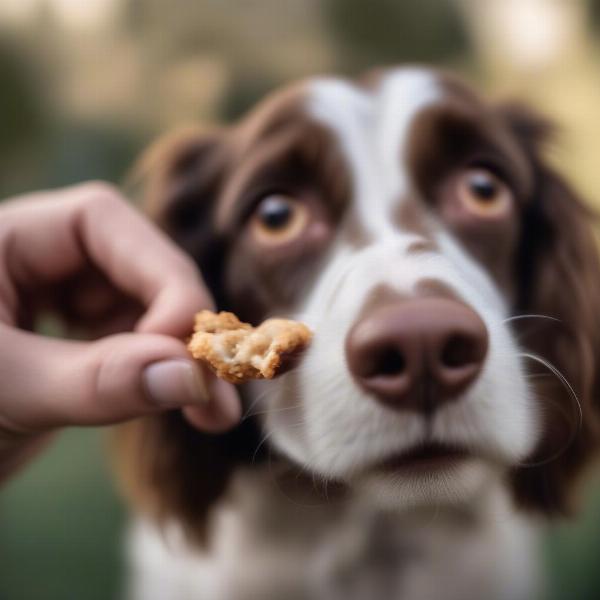Managing a diabetic dog’s diet can feel overwhelming, especially when it comes to treats. You want to reward your furry friend, but you also need to keep their blood sugar levels stable. Choosing the right treats for diabetic dogs is crucial for their health and wellbeing. This guide will walk you through everything you need to know about selecting safe and healthy treats for your diabetic companion.
Understanding Diabetes in Dogs
Before diving into treat options, it’s important to understand what diabetes is and how it affects dogs. Just like in humans, canine diabetes occurs when the body doesn’t produce enough insulin or can’t use it effectively. This leads to elevated blood glucose levels, which can cause a range of health problems if not managed properly. A key aspect of managing diabetes is regulating blood sugar through diet, including treats.
 Diabetic dog eating a treat
Diabetic dog eating a treat
Choosing Safe Treats for Diabetic Dogs
Not all dog treats are created equal, especially for diabetic dogs. Avoid treats high in sugar, carbohydrates, and artificial sweeteners. Instead, look for options that are low in these ingredients and high in fiber and protein. Here are some key factors to consider:
- Ingredients: Scrutinize the ingredient list carefully. Look for natural, whole-food ingredients and avoid added sugars, corn syrup, and artificial sweeteners like xylitol, which is toxic to dogs.
- Glycemic Index (GI): Opt for treats with a low GI, as these will have a minimal impact on blood sugar levels. Foods with a high GI can cause rapid spikes in blood glucose.
- Fiber Content: High-fiber treats can help regulate blood sugar and promote digestive health.
- Protein Content: Protein can help maintain muscle mass and provide sustained energy without significantly affecting blood glucose.
Recommended Treats for Diabetic Dogs
While commercial treats marketed specifically for diabetic dogs are available, you can also offer some healthy human foods as treats in moderation. Here are a few suggestions:
- Vegetables: Small pieces of carrots, green beans, or cucumbers can be a refreshing and low-calorie treat.
- Fruits (in moderation): Berries like blueberries and strawberries are relatively low in sugar and high in antioxidants.
- Plain, Cooked Chicken or Turkey: Small pieces of lean protein can be a satisfying and nutritious treat.
- Commercial Diabetic Dog Treats: Look for reputable brands that prioritize low-sugar and high-fiber ingredients.
What to Avoid
Certain ingredients are absolutely off-limits for diabetic dogs:
- Sugary Treats: Avoid anything with added sugar, honey, molasses, or corn syrup.
- Artificial Sweeteners: Xylitol is extremely toxic to dogs and can cause liver failure. Other artificial sweeteners may also be harmful.
- High-Carbohydrate Treats: White bread, crackers, and other processed snacks can cause significant blood sugar spikes.
Monitoring Your Dog’s Response
Even with safe treats, it’s essential to monitor your dog’s blood glucose levels regularly. This will help you determine how different treats affect their blood sugar and adjust their diet accordingly. Consult your veterinarian for guidance on monitoring and adjusting your dog’s insulin dosage if needed.
Conclusion
Choosing the right treats for your diabetic dog requires careful consideration of ingredients, GI, fiber, and protein content. By following these guidelines and working closely with your veterinarian, you can provide your furry friend with safe and enjoyable treats while effectively managing their diabetes. Remember, a balanced diet, including appropriate treats, is key to keeping your diabetic dog happy and healthy.
FAQ
- Can I give my diabetic dog any treats at all? Yes, but they must be carefully chosen and given in moderation. Focus on low-sugar, high-fiber options.
- What if my dog’s blood sugar spikes after a treat? Consult your veterinarian immediately to discuss adjusting their insulin dosage or diet.
- Are commercial diabetic dog treats always safe? While many are formulated for diabetic dogs, always check the ingredients carefully.
- Can I use human food as treats for my diabetic dog? Yes, certain human foods like vegetables and lean protein can be suitable treats in moderation.
- How often can I give my diabetic dog treats? This depends on their individual needs and dietary plan. Consult your veterinarian for guidance.
- What are the signs of low blood sugar in dogs? Signs include weakness, lethargy, tremors, and seizures. If you observe these symptoms, contact your veterinarian immediately.
- Can treats replace meals for a diabetic dog? No, treats should complement a balanced diabetic diet, not replace meals.
Related Articles on ILM Dog
About ILM Dog
ILM Dog (https://ilmdog.com) is your trusted global resource for all things dog-related. We offer expert advice on dog breeds, health, training, nutrition, grooming, and much more. Whether you’re a new dog owner or a seasoned expert, we provide practical, reliable information to help you provide the best possible care for your canine companion. For expert guidance on dog nutrition and health, contact us at [email protected] or +44 20-3965-8624.